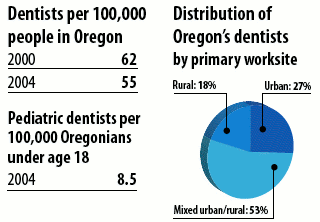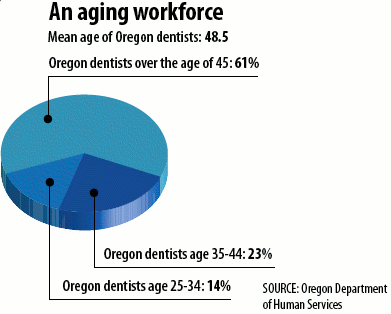Every year, about 75 new dentists graduate from the Oregon Health & Science University School of Dentistry, 50 to 60 of whom go on to practice in Oregon.
 Dental pain
Dental pain
A looming shortage of dentists means lack of access, care throughout the state.
By Jon Bell
Every year, about 75 new dentists graduate from the Oregon Health & Science University School of Dentistry, 50 to 60 of whom go on to practice in Oregon.
Every year, the state’s only dental school has 75 openings for new students. And every year for the past few years, the school has had more than 1,000 prospective students apply for those 75 openings.
Those numbers would seem to indicate not only that there are plenty of aspiring dentists out there, but also that there is an ample supply of new dentists joining the Oregon ranks every year.
The reality, however, is that dentistry in Oregon may be facing a workforce shortage similar to that of many other health-care professions. But even more pressing than the fact that the number of new dentists isn’t quite keeping pace with population growth is that rural access issues, a graying workforce, educational debt and an unequal distribution of care are all taking a bite out of the future stability of dentistry in Oregon.
Oregon, like a lot of other Western states, has a huge distribution problem, besides a growth issue, says Jack Clinton, dean of the OHSU School of Dentistry. “There’s a numbers problem and a distribution problem, so getting dental care to the Oregon population is a very intense challenge.”
According to the Oregon Dental Association, there are about 2,500 dentists licensed in the state, some of whom are retired or practice outside of Oregon. Both Clinton and William Zebb, president of the ODA, cite studies from the American Dental Association that point to a potential future workforce shortage on the national level.
“Where we sit right now, they’re projecting that there might be a dip [in dental workers] around 2010,” says Zepp.
PART OF WHAT COULD CAUSE THE SHORTAGE in Oregon is strong population growth. Oregon was one of the 10 fastest-growing states in 2005, and population is expected to grow by 1.4% annually over the next three years.
fastest-growing states in 2005, and population is expected to grow by 1.4% annually over the next three years.
Such steady growth could make it hard for dentistry to maintain a sufficient dentist-to-patient ratio, although variables, from regional demographics to increased dentist productivity, can account for and offset imbalances.
In Oregon in 2004, there were about 55 dentists per 100,000 people, down from 62 per 100,000 four years earlier, according to a recent report from the state Department of Human Services (DHS).
Another trend putting the squeeze on Oregon dentistry — and also surfacing in professions from truck driving and farming to nursing— is that of an aging workforce.
In 2002, the Oregon Health Workforce Project found that the average age of dentists in Oregon was 49; in addition, 61% of active dentists were over the age of 45 and 31% were 55 or older.
That gradual graying mirrors the population as a whole, so not only are dentists getting older, but as the baby boomers are aging, they’re requiring more oral care.
“The graying of our population — it’s exactly the same in the dental profession and it’s equally the same in Oregon,” says Clinton, who’s worked at the OHSU School of Dentistry since 1964. “A great number of our dental providers have retired or will soon.”
 Exacerbating the dental outlook even further is the issue of care distribution, a particular ache in a state like Oregon with its urban and rural extremes. According to the Workforce Project, more than 80% of the state’s dentists practice in urban or mixed urban/rural areas; 18% practice in rural areas. “We probably have plenty of dental providers in the Portland metro area,” Clinton says, “but you go out to counties such as Gilliam, Lake and Klamath, and they’re very underserved.”
Exacerbating the dental outlook even further is the issue of care distribution, a particular ache in a state like Oregon with its urban and rural extremes. According to the Workforce Project, more than 80% of the state’s dentists practice in urban or mixed urban/rural areas; 18% practice in rural areas. “We probably have plenty of dental providers in the Portland metro area,” Clinton says, “but you go out to counties such as Gilliam, Lake and Klamath, and they’re very underserved.”
Shanie Mason, Oral Health Program Manager for the DHS, says all but nine of Oregon’s counties contain designated shortage areas for dental health professionals. Such designations are based on the following factors: geography — for example, the eastern half of Baker County; migrant farm workers, such as in Umatilla County; low income, as in Coos County; and homelessness, as in Multnomah County.
That such a cross-section of counties contains shortage areas reveals the paucity of oral care manifests itself in different ways, from geographic isolation to a lack of resources.
“Rural residents and urban residents have the same need in terms of oral health,” Mason says. “Where the differences come in is in the challenges meeting those needs.”
IT IS NEVERTHELESS IN THE RURAL AREAS of the state where the shortage — which also encompasses dental hygienists — is most acute. Far fewer oral specialists, such as endodontists and periodontists, practice in rural areas; of the state’s 79 licensed pediatric dentists, just 27 practice outside the Portland metro region.
Dentist Sean Benson has been practicing in Baker City for more than four years now. He says many of his patients drive from John Day or La Grande, a drive that for those used to the rural way of life “isn’t viewed as a big hardship.” An avid rock climber and skier who relishes Baker’s small-town vibe, Benson says many young dentists fresh out of school falsely believe that the key to financial success is to practice in an urban area.
Burdened with educational debt — the average for dental school graduates is in the neighborhood of $130,000 — and the prospect of spending up to $1 million on an independent practice, many young dentists stick close to urban cores, Benson says.
“I think you’ve got to dispel the notion that a practice is more lucrative and more rewarding in the metro areas,” he says, noting that his small-town location provides him with a sizable patient pool.
OHSU has begun work on several initiatives to help get a handle on the possible dental shortage and the distribution issue in Oregon.
Long-term, the school of dentistry has plans for a new and larger campus in Portland’s South Waterfront district. As that’s still at least six years off, Clinton says in the interim the school has launched a pilot program that may eventually require all senior students to serve as a resident for a few weeks in a rural setting.
“It’s less about dentistry and more about quality of life,” he says. “I think it will be a very, very powerful way of influencing the distribution of care.”
The school may also institute a one-year residency for graduates that emphasizes intense training in dental specialties, thus better equipping dentists for work in underserved areas.
The ODA, too, is working to address the overall issue. Brett Hamilton, managing director of public and professional education, says the association regularly lobbies to protect OHSU’s budget. The ODA also has pushed for tax credits and loan forgiveness to serve as incentives for dentists to practice in rural, underserved areas.
But more than anything, the 1,500-member ODA pushes water fluoridation as a way to help solve dental workforce and access issues. Oregon ranks 48th among states for water fluoridation.
ODA and others believe that the preventive benefits of fluoridating community water sources can improve overall oral health and help ease some of the pressure on Oregon’s dentists.
“There’s such an obvious answer,” Hamilton says. “Prevention. It’s not going to solve everything, but it’s going to help.”
Have an opinion? E-mail [email protected]



